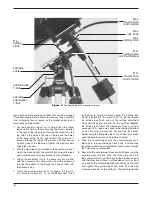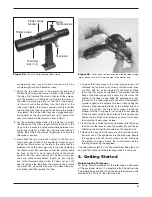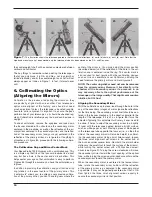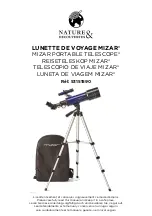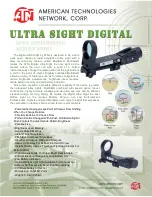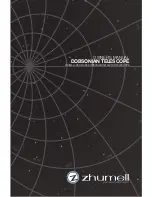
16
Then follow the same procedure described below for cleaning
the primary mirror. The secondary mirror is glued into its hold-
er, and should not be removed from the holder for cleaning.
To clean the primary mirror, carefully remove the mirror cell
from the telescope. This is done by first removing the three
primary mirror collimation screws indicated in Figure 15.
Next, remove the primary mirror from the mirror cell; you will
need to remove the three mirror clips to do this. Completely
unthread the two Phillips head screws in each clip, and care-
fully lift the mirror from its cell. Be careful not to touch the
front surface of the mirror with your fingers! Set the mirror on
a clean, soft towel. Fill a clean sink, free of abrasive cleanser,
with room-temperature water, a few drops of liquid dishwash-
ing detergent, and if possible, a cap-full of rubbing alcohol.
Submerge the mirror (aluminized face up) in the water and let
it soak for several minutes (or hours if it’s a very dirty mirror).
Wipe the mirror under water with clean cotton balls, using
extremely light pressure and stroking in straight lines across
the surface. Use one ball for each wipe across the mirror.
Then rinse the mirror under a stream of lukewarm water. Any
particles on the surface can be swabbed gently with a series
of clean cotton balls, each used just one time. Dry the mirror
in a stream of air (a “blower bulb” works great), or remove any
stray drops of water with the corner of a paper towel. Water
will run off a clean surface. Cover the mirror surface with
Kleenex, and leave the entire assembly in a warm area until it
is completely dry before reassembling the telescope.
9. Specifications
Optical tube: Steel
Primary mirror diameter: 130mm
Primary mirror coating: Aluminized, silicon dioxide overcoat
Secondary mirror minor axis: 34mm
Focal length: 900mm
Focal ratio: f/7
Eyepieces: 25mm and 10mm Explorer II, fully coated, 1.25”
Magnification: 36x (with 25mm), 90x (with 10mm)
Focuser: Rack and pinion
Finder scope: 6x magnification, 30mm aperture, achromatic,
crosshairs
Mount: EQ-2 German-type equatorial
Tripod: Aluminum
Motor drives: Optional
Figure 15.
Remove the three
collimation screws
indicated to remove
the mirror cell from
the tube.
One-Year limited Warranty
This Orion SpaceProbe 130mm Equatorial Reflector is warranted against defects in materials or workmanship for
a period of one year from the date of purchase. This warranty is for the benefit of the original retail purchaser only.
During this warranty period Orion Telescopes & Binoculars will repair or replace, at Orion’s option, any warranted
instrument that proves to be defective, provided it is returned postage paid to: Orion Warranty Repair, 89 hangar
Way, Watsonville, CA 95076. If -the product is not registered, proof of purchase (such as a copy of the original
invoice) is required.
This warranty does not apply if, in Orion’s judgment, the instrument has been abused, mishandled, or modified,
nor does it apply to normal wear and tear. This warranty gives you specific legal rights, and you may also have
other rights, which vary from state to state. For further warranty service information, contact: Customer Service
Department, Orion Telescopes & Binoculars, 89 hangar Way, Watsonville, CA 95076; (800) 676-1343.
Orion telescopes & Binoculars
89 Hangar Way, Watsonville, CA 95076
Customer Support Help Line (800) 676-1343 • Day or Evening



